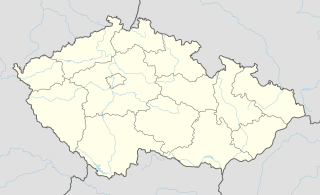Býčí skála
| Býčí skála
|
||
|---|---|---|
|
Entrance to the Býčí skála cave |
||
| Location: | between Adamov and Křtiny , Czech Republic | |
|
Geographic location: |
49 ° 18 '27 " N , 16 ° 41' 41" E | |
|
|
||
| Geology: | Shell limestone | |
| Overall length: | 13,070 m | |
| Level difference: | 249 m | |
The Býčí skála cave (German: bull rock) is located in the Czech Republic in the center of the Moravian Karst protected landscape area . Together with the neighboring Rudické propadání cave , it forms the second longest cave system in the Czech Republic. The Býčí skála cave was already used by humans in prehistoric times. Internationally known finds come mainly from the Hallstatt period .
description
The cave is located about 20 km north of Brno between Adamov and Křtiny , near the small settlement Josefov. A large limestone rock rises above the cave entrance ; the cave spaces were formed by the action of water in limestones of the Devonian . The entrance leads into a hall, from which the lower passages, chimneys and other cave rooms can be reached. The total length of the known corridors is over 13 km. Parts of the system are temporarily flooded or are permanently under water.
The cave itself and its surrounding area is protected as the Býčí Skála National Nature Reserve . The protected area, declared in 2004, is 190.8 hectares in size and includes the deeply cut valley of the Křtinský creek . In addition to Býčí skála itself, there are also other karst elements, for example the Jáchymka cave, which has become known through fossil finds, or the Barová, Kostelík and Tři kotle caves. The caves serve as winter quarters for bats . The great mouse-eared bat is the most common , along with the lesser horseshoe bat and the ciliated bat . The area is cut through by the road from Adamov to Křtiny and made accessible by two nature trails. The area is made up of fir and oak forests.
history
The spacious cave has been used by people since the Paleolithic , although in the past only the entrance hall and an approximately 300 m long corridor were accessible. In 1663 it found its way into the literature with the description of MA Vigsel, Premonstratensian from Brno. In the 18th century, workers from the nearby ironworks mined the local gravel deposits; they repeatedly found human bones and pieces of coal. Archaeological exploration began in the mid-19th century. The doctor and archaeologist Heinrich Wankel carried out excavations in the cave since 1867 . First he discovered the remains of a camp of reindeer hunters from Magdalenian in the back corridor . Two years later, two students found the bronze statuette of a bull, which has become the symbol of the cave. In 1872 Wankel succeeded in the spectacular discovery of the so-called "Hallstatt burial". In the floor of the entrance hall he found more than 40 skeletons and objects from the Hallstatt period , such as ceramics, jewelry, weapons and tools. The finds also included an area that is interpreted as a blacksmith's workshop and two large fire places that indicate the use as a cult site. The remains were embedded in a layer of charcoal up to half a meter thick. Some of the skeletons were incomplete, the head or limbs were missing. Wankel interpreted the find as a ritual burial. However, there are other interpretations, such as that of an accident or an enemy attack on a group of miners. The finds are now kept in the Natural History Museum in Vienna.
The original shape of the entrance hall was permanently changed in the Second World War when the German occupiers built an arms factory there. The floor was poured with concrete and both entrances were closed. Knowledge of the rear passages of the cave system expanded in speleological investigations in the 20th century. In 1920 the siphon at the end of the well-known passage was exhausted and a new cave room was discovered. It was the bed of the Jedovnický potok that rises to the surface near the cave entrance. Up until 1992, every meter of the underground stream and thus the connection between the Býčí skála and Rudické propadání caves was systematically investigated. The Býčí skála cave is not open to the public. Guided tours take place three times a year.
literature
- Býčí skála cave . In: Warriors and Salt Lords. Exhibition supplement (1970) 99 ff.
- Parzinger, H./J. Nekvasil / FE Barth: The Býčí skála cave. A Hallstatt-era cave offering place in Moravia (1995).
- Peter-Röcher, H .: The Býčí skála cave in Moravia - sacrifice, ancestral cult and death ritual in the Hallstatt period . Das Altertum 44, 1988, 3 ff.
- Oliva, Martin: The paleolithic from the Býčí skála cave . Pravěk NŘ 5, 1995, 25-38.


